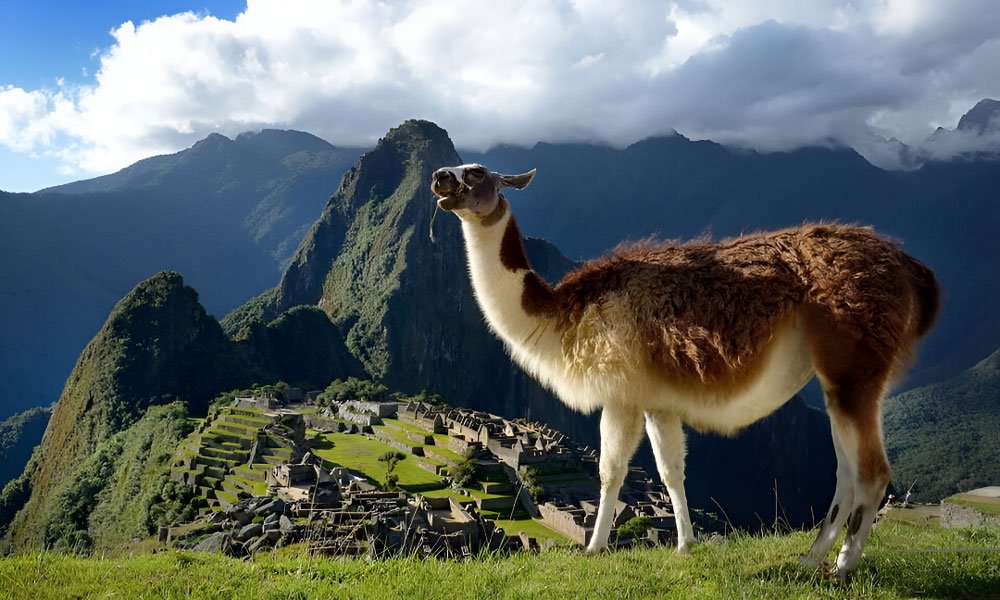All about Machu Picchu | Summary
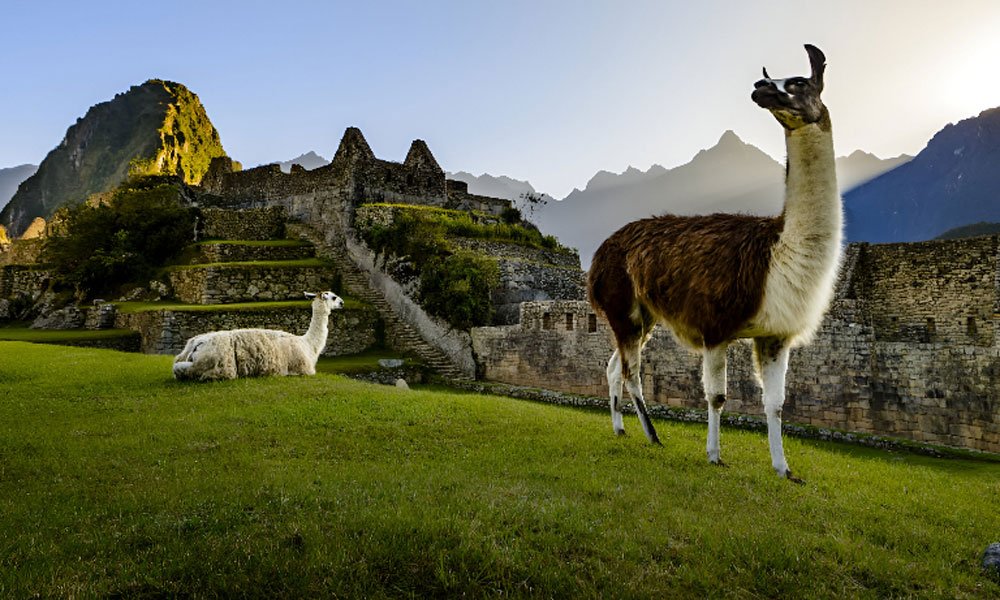 All about Machu Picchu | Summary
All about Machu Picchu | Summary
Machu Picchu is considered one of the seven wonders of the modern world. Located high in the Peruvian Andes, it is surrounded by breathtaking mountain scenery and lush vegetation.
The citadel itself is an amazing testament to the architectural skill of the ancient Incas. It is built on terraced steps that adapt perfectly to the mountainous topography, and its buildings are made of large blocks of carved stone that fit together without the need for mortar. The temples, plazas, and dwellings are carefully designed, showcasing the precision and advanced engineering of the Inca civilization.
Description:
One of the highlights of Machu Picchu is the Intihuatana, a carved stone structure that serves as a sundial. Other important sites include the Temple of the Sun, the Temple of the Three Windows, and the Sacred Rock, each with its own meaning and mystery.
In addition to its impressive architecture, Machu Picchu offers panoramic views of the surrounding mountains, deep valleys, and the Urubamba River winding through the landscape. The diversity of flora and fauna in the region is also remarkable, as it is home to a wide variety of plant and animal species.
The mystical atmosphere and the feeling of being in a place far removed from modern civilization make visiting Machu Picchu an unforgettable experience. The fog that sometimes envelops the site adds a touch of mystery and creates a magical atmosphere.
Although it is a popular tourist destination, the vast expanse of Machu Picchu allows for moments of tranquility and contemplation, especially on the trails leading to the citadel or in the areas furthest from the main site. There, you can appreciate the grandeur of this ancient wonder and connect with the history and splendor of the Inca civilization.
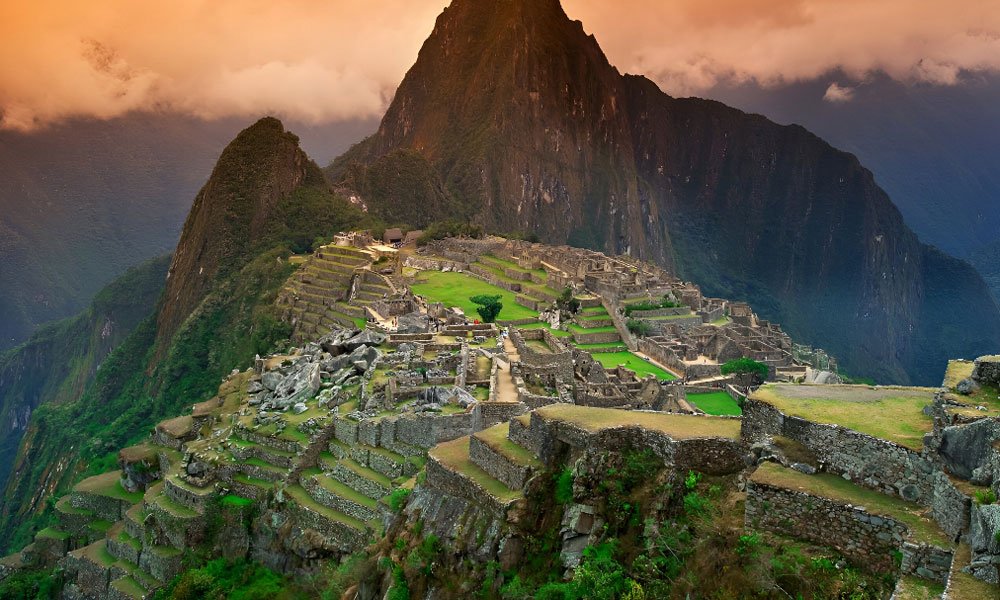
The History of Machu Picchu, Short Summary
Machu Picchu has a fascinating history dating back to the Inca Empire, which flourished in the 15th century in the Andes region. Although the exact purpose of Machu Picchu is unknown, it is believed to have served as a sacred city, a ceremonial center, and possibly a royal residence for the Inca emperor.
The construction of Machu Picchu is attributed to the Inca emperor Pachacútec, who ruled from 1438 to 1471. It is believed that construction began around 1450 and took approximately 30 years to complete. The citadel was built using highly sophisticated Inca construction techniques, with stone blocks perfectly fitted together without the use of mortar.
Machu Picchu was inhabited for only about 100 years before being suddenly abandoned. It is believed that the abandonment of the citadel was related to the Spanish conquest and the fall of the Inca Empire. However, unlike other Inca cities, Machu Picchu was not discovered or looted by the Spanish, which contributed to its excellent state of preservation.
The existence of Machu Picchu as a lost city was little known outside the region until American explorer Hiram Bingham discovered it in 1911. Since then, Machu Picchu has gained worldwide recognition as an archaeological wonder and one of South America’s most important tourist destinations.
In recognition of its historical and cultural importance, Machu Picchu was designated a UNESCO World Heritage Site in 1983. In addition, in 2007, it was included in the list of the New Seven Wonders of the World in a global vote.
What does Machu Picchu mean?
The word Machu Picchu originates from the Quechua language, which was the language of the Incas and is still spoken in many communities in the Andes. In Quechua, Machu Picchu means “old mountains.” This name was arbitrarily assigned by local residents, who referred to the mountain in this way.
However, various studies suggest that the original name of Machu Picchu could be ‘Patallaqta’, a Quechua word meaning ‘town of steps’. This theory is based on the design of the citadel, with its terraces and characteristic stepped constructions.
Today, Machu Picchu is also used to refer to the town of Aguas Calientes, located at the foot of the Inca wonder. The large mountain on which the archaeological site sits is also known by this name.
In addition, in Peru, a famous cocktail has been named ‘Machu Picchu’, which is made with pisco, the country’s emblematic spirit. This cocktail comes in green, yellow, and red, which are the colors of the Peruvian flag.
Location of Machu Picchu
Machu Picchu is an ancient Inca citadel located in the mountainous region of the Andes in Peru. It is located in the province of Urubamba, within the region of Cusco. More specifically, Machu Picchu is located on a mountain ridge.
Coordinates
Latitude: -13.1631412
Longitude: -72.5449629
Altitude
Machu Picchu is located at an altitude of 2,453 meters above sea level.
Climate
Machu Picchu has a warm and humid climate, with average temperatures ranging between 12°C and 24°C.
There are two seasons:
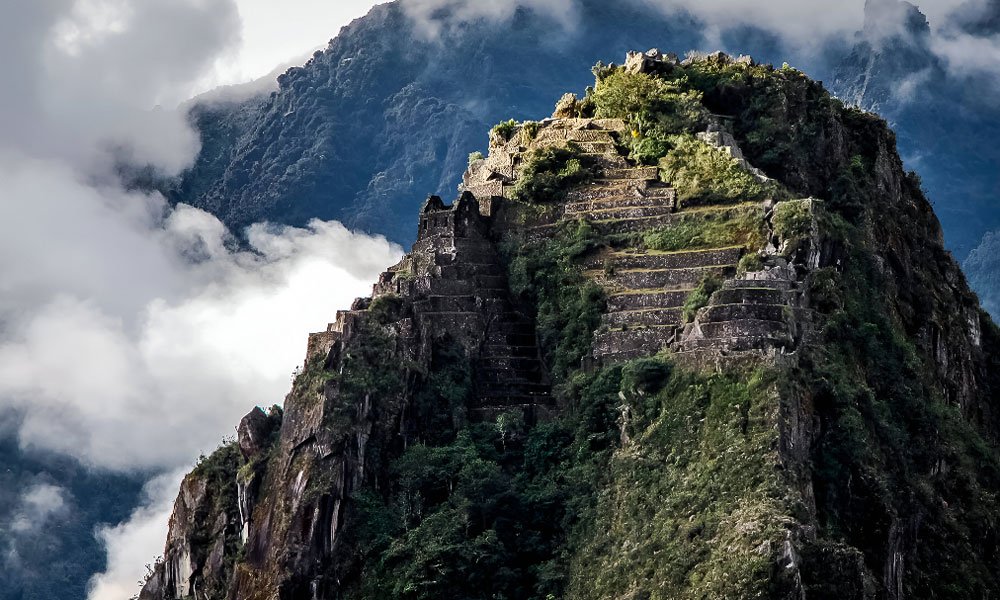
Rainy season: from October to March, when there is rainfall, most frequently in January and February.
Dry season: from April to September, when the days are sunny and it rains occasionally.
The mountains: Huayna Picchu and Machu Picchu Mountain
Machu Picchu offers more than just temples, enclosures, and mysterious Inca buildings. It also includes incredible hikes to its most famous mountains: Huayna Picchu and Machu Picchu Mountain. Both routes were laid out by the Incas themselves to honor their gods at the highest point of the site. From their summits, you can enjoy beautiful views of the archaeological site. In addition, you can appreciate abundant flora, fauna, and mysterious temples.
- Huayna Picchu Mountain – This summit is the one that stands out in the classic postcard photo of Machu Picchu. On its summits, the Incas built hundreds of stone steps, some of which are close to precipices. That is why entry is only allowed to tourists over 12 years of age. This adventure is considered an exciting experience. You can also visit mysterious constructions such as the Temple of the Moon. Entry is with the ‘Machu Picchu + Huayna Picchu’ ticket.
- Machu Picchu Mountain – This imposing mountain is where the archaeological site of Machu Picchu is located. Its name was taken to name the Inca city, although it is believed that its real name was ‘Patallacta’. On the mountain, the Incas traced paths ascending to its summit. From there, you have the highest view of the Inca complex. You can also observe a diversity of flora and fauna. Admission is for visitors of any age and is done with the ‘Machu Picchu + Mountain’ ticket.
Flora and Fauna in Machu Picchu
Machu Picchu is not only a historical and cultural site, but also home to a varied and exotic biodiversity. Thanks to its location between the Andes and the Peruvian Amazon, diverse species have the opportunity to thrive in this area. In addition, the Urubamba River runs through the sanctuary from east to west.
In this natural environment, you can find species such as the Andean fox, puma, vizcacha, spectacled bear, and white-tailed deer, among others. In addition, Machu Picchu has more than 420 species of birds, including the cock-of-the-rock and the Andean condor. There are also around 377 species of butterflies, 15 species of amphibians, and 25 species of reptiles, including 9 types of lizards and 16 snakes.
This wonder of the modern world covers more than 30,000 hectares, including wooded areas, rugged mountains, peaks, and snow-capped mountains. In terms of flora, there are tree species such as alder, white cedar, cascarilla, yanay, and laurel. There are also forests of unca, queñua, and t’asta.
Orchids deserve special attention in Machu Picchu, as 370 types have been recorded, representing approximately 20% of the species identified in Peru. These beautiful flowers can be found along the trails and paths that cross the sanctuary, as well as in a nature reserve near the Vilcanota River. This reserve is home to the world’s largest collection of native orchids, according to the American Orchid Society.
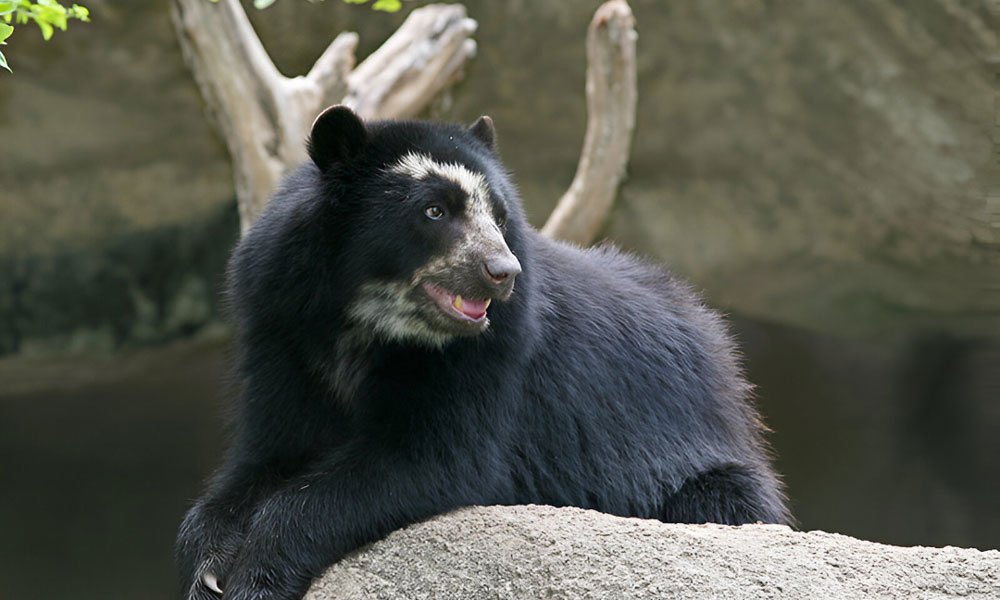
When is the best time to visit Machu Picchu?
Depending on the time of year, there are two distinct seasons: the dry season, which runs from April to October, and the rainy season, which runs from November to March. During the dry season, there is less rain and cloud cover, while during the rainy season, precipitation and cloud cover are more frequent. January, February, and March are the rainiest months.
Access Routes to Machu Picchu
The train ride from Ollantaytambo is one of the most impressive routes to Machu Picchu. This route passes through the beautiful landscapes of the Sacred Valley of the Incas until it reaches Machu Picchu. Most visitors choose to take a minivan from Cusco to Ollantaytambo and then continue by train to Aguas Calientes. From this town, you can take a bus or walk to the entrance of Machu Picchu.
Another option is the bus trip from Hidroeléctrica, a lesser-known but equally interesting route. This tour begins in Cusco and passes through mountain landscapes until it reaches the town of Aguas Calientes, located in the transition zone between the mountains and the jungle. The journey begins in the city of Cusco, where you take a bus to the town of Santa María. Then you continue to Santa Teresa and, from there, you arrive at the Hidroeléctrica station. Finally, you must walk or take a train to Aguas Calientes, at the foot of Machu Picchu. In total, this route can take around 6 to 7 hours.
The famous Classic Inca Trail route, which is an option for hiking enthusiasts. This trail follows part of the ancient Inca road network that connected Cusco with Machu Picchu. Visitors walk 39 kilometers over 4 days and 3 nights, camping at different points until they reach the Inca city through the Sun Gate, which was the ancient entrance used by the Incas. There is also a shorter option known as the “Short Inca Trail,” which takes only 2 days.
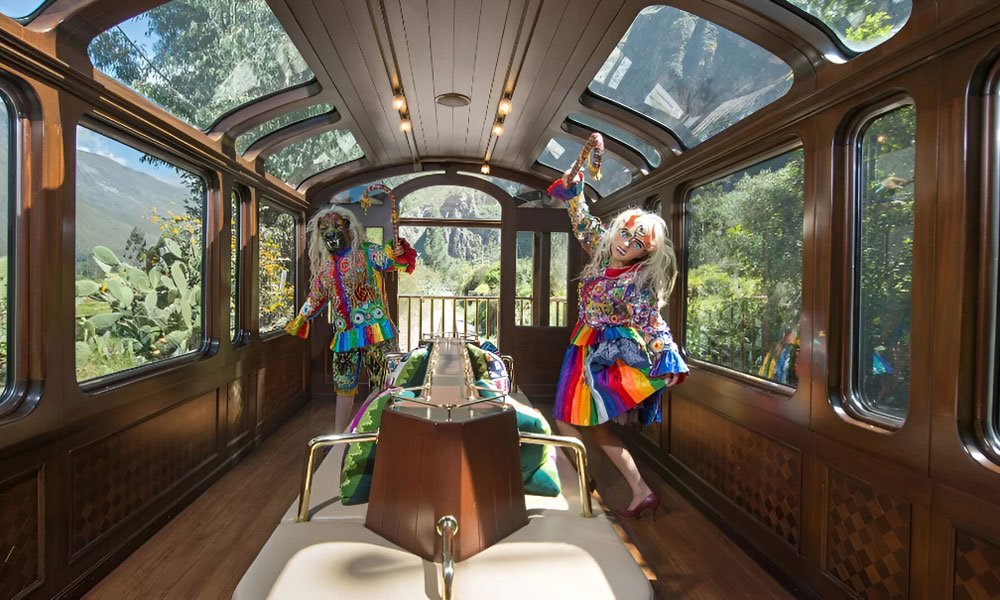
Recommendations
Book in advance: Machu Picchu is a very popular tourist attraction, so it is recommended to book both entrance tickets and transportation, such as trains and buses, in advance, especially during the high season. I recommend using a travel agency to help you plan and organize your trip. You can visit CHULLOS TRAVEL.
Choose the right time: The dry season, which runs from April to October, is considered the best time to visit Machu Picchu, as there is less chance of rain and the days are usually sunnier. However, keep in mind that there are also more tourists during these months. Avoid the months with heavy rainfall, such as January, February, and March, if you are not comfortable with the weather conditions.
Get physically prepared: If you plan to hike the Inca Trail or any other hiking route, it is important to be in good physical shape. Train and do endurance exercises in advance to ensure that you can complete the hike safely and fully enjoy the experience.
Wear appropriate clothing: The weather in Machu Picchu can vary, even during the same day, so wear layers of clothing that you can add or remove as needed. Also, don’t forget to wear comfortable and sturdy walking shoes, as well as a raincoat or waterproof jacket in case of rain.
Protect yourself from the sun: The sun at Machu Picchu can be strong, especially at higher altitudes. Don’t forget to bring sunscreen, a hat or cap, sunglasses, and clothing that protects you from UV rays.
Stay hydrated and bring snacks: Stay hydrated during your visit, as altitude and physical activity can increase your need for fluids. Bring a reusable water bottle and some energy snacks to keep your energy up throughout the day.
Respect the site: Machu Picchu is an important and fragile archaeological site. Follow the signs and rules established for the visit, such as not touching or damaging the structures, not leaving trash behind, and respecting the sacred spaces.
